Metabolomic Analysis of the Responses of Bryophyte Tortella tortuosa (Hedw.) Limpr. to Cadmium (Cd) Stress
Abstract
1. Introduction
2. Results
2.1. Data Preprocessing
2.2. Expression of DAMs
2.3. Pathway Enrichment Analysis
2.4. Visual Analysis of DAMs-Enriched Metabolic Pathways
2.5. Differential Metabolite Abundance Profiles
2.6. Correlation Analysis Between DAMs and T. tortuosa Physiological Characteristics and Cd Content
3. Discussion
4. Materials and Methods
4.1. Study Area
4.2. Experimental Design
4.3. Determination of Physiological Indices
4.4. Metabolomic Assays
4.5. Data Analysis
5. Conclusions
Supplementary Materials
Author Contributions
Funding
Institutional Review Board Statement
Informed Consent Statement
Data Availability Statement
Conflicts of Interest
References
- Guo, S.H.; Hu, N.; Li, Q.S.; Yang, P.; Wang, L.L.; Xu, Z.M.; Chen, H.J.; He, B.Y.; Zeng, E.Y. Response of edible amaranth cultivar to salt stress led to Cd mobilization in rhizosphere soil: A metabolomic analysis. Environ. Pollut. 2018, 241, 422–431. [Google Scholar] [CrossRef] [PubMed]
- Sheng, L.; Zhao, W.; Yang, X.; Mao, H.; Zhu, S.X. Response characteristics of rhizosphere microbial community and metabolites of Iris tectorum to Cr stress. Ecotoxicol. Environ. Saf. 2023, 263, 115218. [Google Scholar] [PubMed]
- Bharwana, S.; Ali, S.; Farooq, M.; Ali, B.; Iqbal, N.; Abbas, F.; Ahmad, M.S.A. Hydrogen sulfide ameliorates lead-induced morphological, photosynthetic, oxidative damages and biochemical changes in cotton. Environ. Sci. Pollut. Res. 2014, 21, 717–731. [Google Scholar] [CrossRef] [PubMed]
- Haydon, M.J.; Cobbett, C.S. Transporters of ligands for essential metal ions in plants. New Phytol. 2007, 174, 499–506. [Google Scholar] [CrossRef]
- Bolan, S.; Kunhikrishnan, A.; Seshadri, B.; Choppala, G.; Naidu, R.; Bolan, N.S.; Ok, Y.S.; Zhang, M.; Li, C.G.; Li, F.; et al. Sources, distribution, bioavailability, toxicity, and risk assessment of heavy metal(loid)s in complementary medicines. Environ. Int. 2017, 108, 103–118. [Google Scholar] [CrossRef]
- Singh, S.; Parihar, P.; Singh, R.; Singh, V.P.; Prasad, S.M. Heavy Metal Tolerance in Plants: Role of Transcriptomics, Proteomics, Metabolomics, and Ionomics. Front. Plant Sci. 2016, 6, 1143. [Google Scholar] [CrossRef]
- Cortés-Valadez, P.J.; Baños-López, E.; Hernández-Rodríguez, Y.M.; Cigarroa-Mayorga, O.E. Bryophyte-Bioinspired Nanoporous AAO/C/MgO Composite for Enhanced CO2 Capture: The Role of MgO. Nanomaterials 2024, 14, 658. [Google Scholar] [CrossRef]
- Maresca, V.; Bellini, E.; Landi, S.; Capasso, G.; Cianciullo, P.; Carraturo, F.; Pirintsos, S.; Sorbo, S.; Sanità di Toppi, L.; Esposito, S.; et al. Biological responses to heavy metal stress in the moss Leptodictyum riparium (Hedw.) Warnst. Ecotoxicol. Environ. Saf. 2022, 229, 113078. [Google Scholar]
- Hossain, Z.; Komatsu, S. Contribution of proteomic studies towards understanding plant heavy metal stress response. Front. Plant Sci. 2013, 3, 310. [Google Scholar]
- Fu, H.J.; Yu, H.Y.; Li, T.X.; Zhang, X.Z. Influence of cadmium stress on root exudates of high cadmium accumulating rice line (Oryza sativa L.). Ecotoxicol. Environ. Saf. 2018, 150, 168–175. [Google Scholar] [CrossRef]
- Zhang, X.T.; Yang, M.; Yang, H.; Pian, R.; Wang, J.X.; Wu, A.M. The Uptake, Transfer, and Detoxification of Cadmium in Plants and Its Exogenous Effects. Cells 2024, 13, 907. [Google Scholar] [CrossRef] [PubMed]
- Li, Z.; Liu, Z.; Chen, R.; Li, X.J.; Tai, P.D.; Gong, Z.Q.; Jia, C.Y.; Liu, W. DNA damage and genetic methylation changes caused by Cd in Arabidopsis thaliana seedlings. Environ. Toxicol. Chem. 2015, 34, 2095–2103. [Google Scholar] [PubMed]
- Shafiq, S.; Zeb, Q.; Ali, A.; Sajjad, Y.; Nazir, R.; Widemann, E.; Liu, L.Y. Lead, Cadmium and Zinc Phytotoxicity Alter DNA Methylation Levels to Confer Heavy Metal Tolerance in Wheat. Int. J. Mol. Sci. 2019, 20, 4676. [Google Scholar] [CrossRef] [PubMed]
- Ali, E.; Hassan, Z.; Irfan, M.; Hussain, S.; Haseeb-ur-Rehman; Shah, J.M.; Shahzad, A.N.; Ali, M.; Alkahtani, S.; Abdel-Daim, M.M. Indigenous Tocopherol Improves Tolerance of Oilseed Rape to Cadmium Stress. Front. Plant Sci. 2020, 11, 547133. [Google Scholar]
- Sun, X.; Zhang, J.; Zhang, H.; Ni, Y.W.; Zhang, Q.; Chen, J.P.; Guan, Y.F. The responses of Arabidopsis thaliana to cadmium exposure explored via metabolite profiling. Chemosphere 2010, 78, 840–845. [Google Scholar]
- Maresca, V.; Badalamenti, N.; Ilardi, V.; Bruno, M.; Bontempo, P.; Basile, A. Chemical Composition of Thymus leucotrichus var. creticus Essential Oil and Its Protective Effects on Both Damage and Oxidative Stress in Leptodictyum riparium Hedw. Induced by Cadmium. Plants 2022, 11, 3529. [Google Scholar]
- Maresca, V.; Fusaro, L.; Sorbo, S.; Siciliano, A.; Loppi, S.; Paoli, L.; Monaci, F.; Karam, E.A.; Piscopo, M.; Guida, M.; et al. Functional and structural biomarkers to monitor heavy metal pollution of one of the most contaminated freshwater sites in Southern Europe. Ecotoxicol. Environ. Saf. 2018, 163, 665–673. [Google Scholar]
- Bellini, E.; Maresca, V.; Betti, C.; Castiglione, M.R.; Fontanini, D.; Capocchi, A.; Sorce, C.; Borsò, M.; Bruno, L.; Sorbo, S.; et al. The Moss Leptodictyum riparium Counteracts Severe Cadmium Stress by Activation of Glutathione Transferase and Phytochelatin Synthase, but Slightly by Phytochelatins. Int. J. Mol. Sci. 2020, 21, 1583. [Google Scholar] [CrossRef]
- Zhang, R.; Chen, P.; Ju, Z.; Tang, H. Phytotoxic responses of acrocarpous moss Campylopus schmidii as bioindicators in copper and cadmium contaminated environments: A comprehensive assessment. Chemosphere 2024, 364, 143082. [Google Scholar]
- Dutta, P.; Prasad, P.; Indoilya, Y.; Gautam, N.; Kumar, A.; Sahu, V.; Kumari, M.; Singh, S.; Asthana, A.K.; Bag, S.K.; et al. Unveiling the molecular mechanisms of arsenic tolerance and resilience in the primitive bryophyte Marchantia polymorpha L. Environ. Pollut. 2024, 346, 123506. [Google Scholar]
- Zechmeister, H.G.; Hohenwallner, D.; Riss, A.; Hanus-Illnar, A. Variations in heavy metal concentrations in the moss species Abietinella abietina (Hedw.) Fleisch. according to sampling time, within site variability and increase in biomass. Sci. Total Environ. 2003, 301, 55–65. [Google Scholar] [CrossRef] [PubMed]
- Okland, T.; OKland, R.H.; Steinnes, E. Element concentrations in the boreal forest moss Hylocomium splendens: Variation related to gradients in vegetation and local environmental factors. Plant Soil 1999, 209, 71–83. [Google Scholar] [CrossRef]
- Chakrabortty, S.; Paratkar, G.T. Biomonitoring of Trace Element Air Pollution Using Mosses. Aerosol Air Qual. Res. 2006, 6, 247–258. [Google Scholar] [CrossRef]
- Salemaa, M.; Derome, J.; Helmisaari, H.S.; Nieminen, T.; Vanha-Majamaa, I. Element accumulation in boreal bryophytes, lichens and vascular plants exposed to heavy metal and sulfur deposition in Finland. Sci. Total Environ. 2004, 324, 141–160. [Google Scholar] [CrossRef] [PubMed]
- Lou, Y.X. Study of Response Mechanism and Bioindication of Bryophytes to Heavy Metal Pollution. Ph.D. Dissertation, Shanghai Normal University, Shanghai, China, 2013. [Google Scholar]
- Jiao, Z.; Shi, Y.; Wang, J.; Wang, Z.F.; Zhang, X.; Jia, X.Y.; Du, Q.; Niu, J.T.; Liu, B.C.; Du, R.H.; et al. Integration of transcriptome and metabolome analyses reveals sorghum roots responding to cadmium stress through regulation of the flavonoid biosynthesis pathway. Front. Plant Sci. 2023, 14, 1144265. [Google Scholar] [CrossRef]
- Zadel, U.; Cruzeiro, C.; Raj Durai, A.C.; Nesme, J.; May, R.; Balázs, H.; Michalke, B.; Płaza, G.; Schröder, P.; Schloter, M.; et al. Exudates from Miscanthus x giganteus change the response of a root-associated Pseudomonas putida strain towards heavy metals. Environ. Pollut. 2022, 313, 119989. [Google Scholar] [CrossRef]
- Tan, P.; Zeng, C.; Wan, C.; Liu, Z.; Dong, X.J.; Peng, J.Q.; Lin, H.Y.; Li, M.; Liu, Z.X.; Yan, M.L. Metabolic Profiles of Brassica juncea Roots in Response to Cadmium Stress. Metabolites 2021, 11, 383. [Google Scholar] [CrossRef]
- Fatnani, D.; Parida, A.K. Unravelling the halophyte Suaeda maritima as an efficient candidate for phytostabilization of cadmium and lead: Implications from physiological, ionomic, and metabolomic responses. Plant Physiol. Biochem. 2024, 212, 108770. [Google Scholar] [CrossRef]
- Sun, L.J.; Cao, X.Y.; Tan, C.Y.; Deng, Y.Q.; Cai, R.Z.; Peng, X.; Bai, J. Analysis of the effect of cadmium stress on root exudates of Sedum plumbizincicola based on metabolomics. Ecotoxicol. Environ. Saf. 2020, 205, 111152. [Google Scholar] [CrossRef]
- Xiao, W.; Zhang, Q.; Zhao, S.; Chen, D.; Gao, N.; Huang, M.J.; Ye, X.Z. Citric acid secretion from rice roots contributes to reduction and immobilization of Cr (VI) by driving microbial sulfur and iron cycle in paddy soil. Sci. Total Environ. 2023, 854, 158832. [Google Scholar] [CrossRef]
- Mao, H.; Zhao, W.; Yang, X.; Sheng, L.Y.; Zhu, S.X. Recruitment and metabolomics between Canna indica and rhizosphere bacteria under Cr stress. Front. Microbiol. 2023, 14, 1187982. [Google Scholar] [CrossRef] [PubMed]
- UdDin, I.; Bano, A.; Masood, S. Chromium toxicity tolerance of Solanum nigrum L. and Parthenium hysterophorus L. plants with reference to ion pattern, antioxidation activity and root exudation. Ecotoxicol. Environ. Saf. 2015, 113, 271–278. [Google Scholar] [CrossRef] [PubMed]
- Galili, G.; Amir, R.; Fernie, A.R. The Regulation of Essential Amino Acid Synthesis and Accumulation in Plants. Annu. Rev. Plant Biol. 2016, 67, 153–178. [Google Scholar] [PubMed]
- Xue, W.; Zhang, C.; Huang, Y.; Wang, C.R.; Zhang, X.; Liu, Z.Q. Rice organs concentrate cadmium by chelation of amino acids containing dicarboxyl groups and enhance risks to human and environmental health in Cd-contaminated areas. J. Hazard. Mater. 2022, 426, 128130. [Google Scholar]
- Di Martino, C.; Delfine, S.; Pizzuto, R.; Loreto, F.; Fuggi, A. Free amino acids and glycine betaine in leaf osmoregulation of spinach responding to increasing salt stress. New Phytol. 2003, 158, 455–463. [Google Scholar] [CrossRef]
- Zhu, G.; Xiao, H.; Guo, Q.; Zhang, Z.Y.; Zhao, J.J.; Yang, D. Effects of cadmium stress on growth and amino acid metabolism in two Compositae plants. Ecotoxicol. Environ. Saf. 2018, 158, 300–308. [Google Scholar]
- Batista-Silva, W.; Heinemann, B.; Rugen, N.; Nunes-Nesi, A.; Araújo, W.L.; Braun, H.P.; Hildebrandt, T.M. The role of amino acid metabolism during abiotic stress release. Plant Cell Environ. 2019, 42, 1630–1644. [Google Scholar]
- Park, W.; Feng, Y.; Kim, H.; Suh, M.C.; Ahn, S.J. Changes in fatty acid content and composition between wild type and CsHMA3 overexpressing Camelina sativa under heavy-metal stress. Plant Cell Rep. 2015, 34, 1489–1498. [Google Scholar]
- Song, W.; Shao, H.; Zheng, A.; Zhao, L.F.; Xu, Y.J. Advances in Roles of Salicylic Acid in Plant Tolerance Responses to Biotic and Abiotic Stresses. Plants 2023, 12, 3475. [Google Scholar] [CrossRef]
- Ali, M.S.; Baek, K.H. Jasmonic Acid Signaling Pathway in Response to Abiotic Stresses in Plants. Int. J. Mol. Sci. 2020, 21, 621. [Google Scholar] [CrossRef]
- Vishwakarma, K.; Upadhyay, N.; Kumar, N.; Yadav, G.; Singh, J.; Mishra, R.K.; Kumar, V.; Verma, R.; Upadhyay, R.G.; Pandey, M.; et al. Abscisic Acid Signaling and Abiotic Stress Tolerance in Plants: A Review on Current Knowledge and Future Prospects. Front. Plant Sci. 2017, 8, 161. [Google Scholar]
- Hu, J.; Tian, J.; Zhang, F.; Wang, H.; Yin, J. Pxr- and Nrf2- mediated induction of ABC transporters by heavy metal ions in zebrafish embryos. Environ. Pollut. 2019, 255 Pt 2, 113329. [Google Scholar]
- Dahuja, A.; Kumar, R.R.; Sakhare, A.; Watts, A.; Singh, B.; Goswami, S.; Sachdev, A.; Praveen, S. Role of ATP-binding cassette transporters in maintaining plant homeostasis under abiotic and biotic stresses. Physiol. Plant. 2021, 171, 785–801. [Google Scholar]
- Li, J.R.; Chen, E.; Islam, Y.; Wang, J.S.; Wu, Z.Q.; Ye, W.B.; Yan, D.L.; Peng, D. Cadmium-induced oxidative stress, response of antioxidants and detection of intracellular cadmium in organs of moso bamboo (Phyllostachys pubescens) seedlings. Chemosphere 2016, 153, 107–114. [Google Scholar]
- Rodrigues-Corrêa, K.C.D.; Fett-Neto, A.G. Abiotic Stresses and Non-Protein Amino Acids in Plants. CRC Crit. Rev. Plant Sci. 2019, 38, 411–430. [Google Scholar]
- Khalid, M.; Rehman, H.M.; Ahmed, N.; Nawaz, S.; Saleem, F.; Ahmad, S.; Uzair, M.; Rana, I.A.; Atif, R.M.; Zaman, Q.U.; et al. Using Exogenous Melatonin, Glutathione, Proline, and Glycine Betaine Treatments to Combat Abiotic Stresses in Crops. Int. J. Mol. Sci. 2022, 23, 12913. [Google Scholar] [CrossRef]
- Sun, W.; Shahrajabian, M.H.; Kuang, Y.; Wang, N. Amino Acids Biostimulants and Protein Hydrolysates in Agricultural Sciences. Plants 2024, 13, 210. [Google Scholar] [CrossRef]
- Zhu, G.; Cheng, D.; Wang, X.; Guo, Q.J.; Zhang, Q.; Zhang, J.; Tu, Q.; Li, W.J. Free amino acids, carbon and nitrogen isotopic compositions responses to cadmium stress in two castor (Ricinus communis L.) species. Plant Physiol. Biochem. 2022, 184, 40–46. [Google Scholar]
- Sebastian, A.; Prasad, M.N.V. Exogenous citrate and malate alleviate cadmium stress in Oryza sativa L.: Probing role of cadmium localization and iron nutrition. Ecotoxicol. Environ. Saf. 2018, 166, 215–222. [Google Scholar]
- Wang, L.L.; Wang, G.; Cui, J.H.; Wang, X.H.; Li, M.; Qi, X.F.; Li, X.M.; Li, Y.Y.; Ma, L.J. Transcriptomics, metabolomics, antioxidant enzymes activities and respiration rate analysis reveal the molecular responses of rice to Cd stress and/or elevated CO2 concentration. Plant Soil 2023, 485, 259–280. [Google Scholar]
- Xu, Q.S.; Qiu, W.J.; Lin, T.T.; Yang, Y.P.; Jiang, Y.J. Cadmium tolerance in Elodea canadensis Michx: Subcellular distribution and metabolomic analysis. Ecotoxicol. Environ. Saf. 2023, 256, 114905. [Google Scholar] [CrossRef]
- Zhang, H.; Du, W.; Peralta-Videa, J.R.; Gardea-Torresdey, J.L.; White, J.C.; Keller, A.; Guo, H.; Ji, R.; Zhao, L. Metabolomics Reveals How Cucumber (Cucumis sativus) Reprograms Metabolites To Cope with Silver Ions and Silver Nanoparticle-Induced Oxidative Stress. Environ. Sci. Technol. 2018, 52, 8016–8026. [Google Scholar] [CrossRef]
- Iqbal, N.; Czékus, Z.; Ördög, A.; Poór, P. Fusaric acid-evoked oxidative stress affects plant defence system by inducing biochemical changes at subcellular level. Plant Cell Rep. 2023, 43, 2. [Google Scholar] [CrossRef]
- Yee, D.A.; Niwa, K.; Perlatti, B.; Chen, M.B.; Li, Y.Q.; Tang, Y. Genome mining for unknown–unknown natural products. Nat. Chem. Biol. 2023, 19, 633–640. [Google Scholar] [CrossRef]
- Song, J.; Zhang, H.; Duan, C.; Cui, X. Exogenous application of succinic acid enhances tolerance of Larix olgensis Seedling to lead stress. J. Forest. Res. 2018, 29, 1497–1505. [Google Scholar] [CrossRef]
- Duan, C.; Wu, S.; Sang, Y.; Bahetibieke, W.; Ru, J.; Song, J.; Cui, X. Exogenous succinic acid mediates responses of Larix olgensis A. Henry to Cadmium Stress. Int. J. Phytoremediat. 2019, 21, 742–751. [Google Scholar] [CrossRef]
- Kiliç, T. Seed treatments with salicylic and succinic acid to mitigate drought stress in flowering kale cv. ‘Red Pigeon F1’. Sci. Hortic. 2023, 313, 111939. [Google Scholar] [CrossRef]
- Rau, S.; Miersch, J.; Neumann, D.; Weber, E.; Krauss, G.J. Biochemical responses of the aquatic moss Fontinalis antipyretica to Cd, Cu, Pb and Zn determined by chlorophyll fluorescence and protein levels. Environ. Exp. Bot. 2007, 59, 299–306. [Google Scholar] [CrossRef]
- Shakya, K.; Chettri, M.K.; Sawidis, T. Impact of heavy metals (copper, zinc, and lead) on the chlorophyll content of some mosses. Arch. Environ. Contam. Toxicol. 2008, 54, 412–421. [Google Scholar] [CrossRef]
- Paoletti, F.; Aldinucci, D.; Mocali, A.; Caparrini, A. A sensitive spectrophotometric method for the determination of superoxide dismutase activity in tissue extracts. Anal. Biochem. 1986, 154, 536–541. [Google Scholar] [CrossRef]
- Cakmak, I.; Marschner, H. Magnesium deficiency and high light intensity enhance activities of superoxide dismutase, ascorbate peroxidase, and glutathione reductase in bean leaves. Plant Physiol. 1992, 98, 1222–1227. [Google Scholar] [CrossRef] [PubMed]
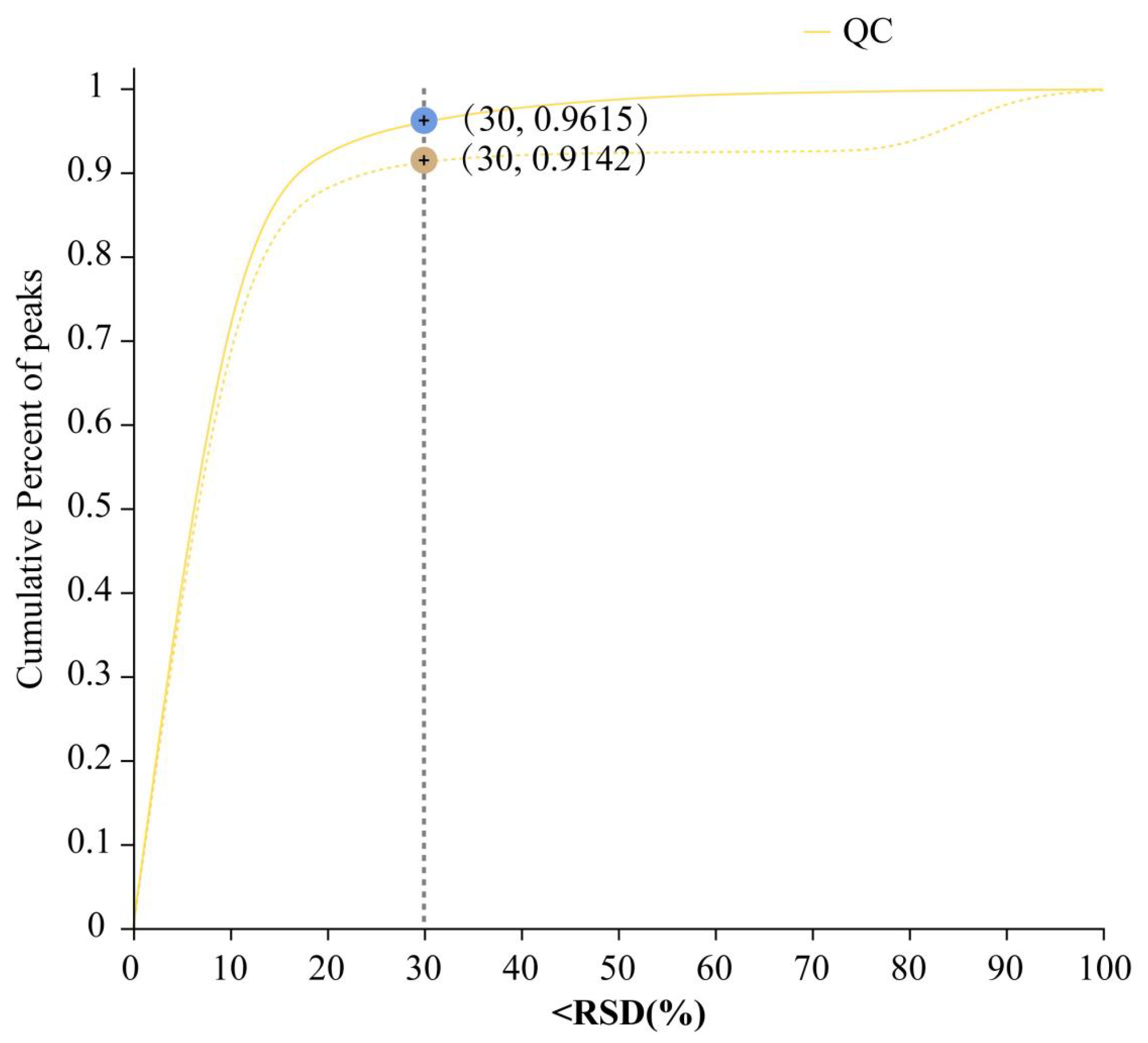
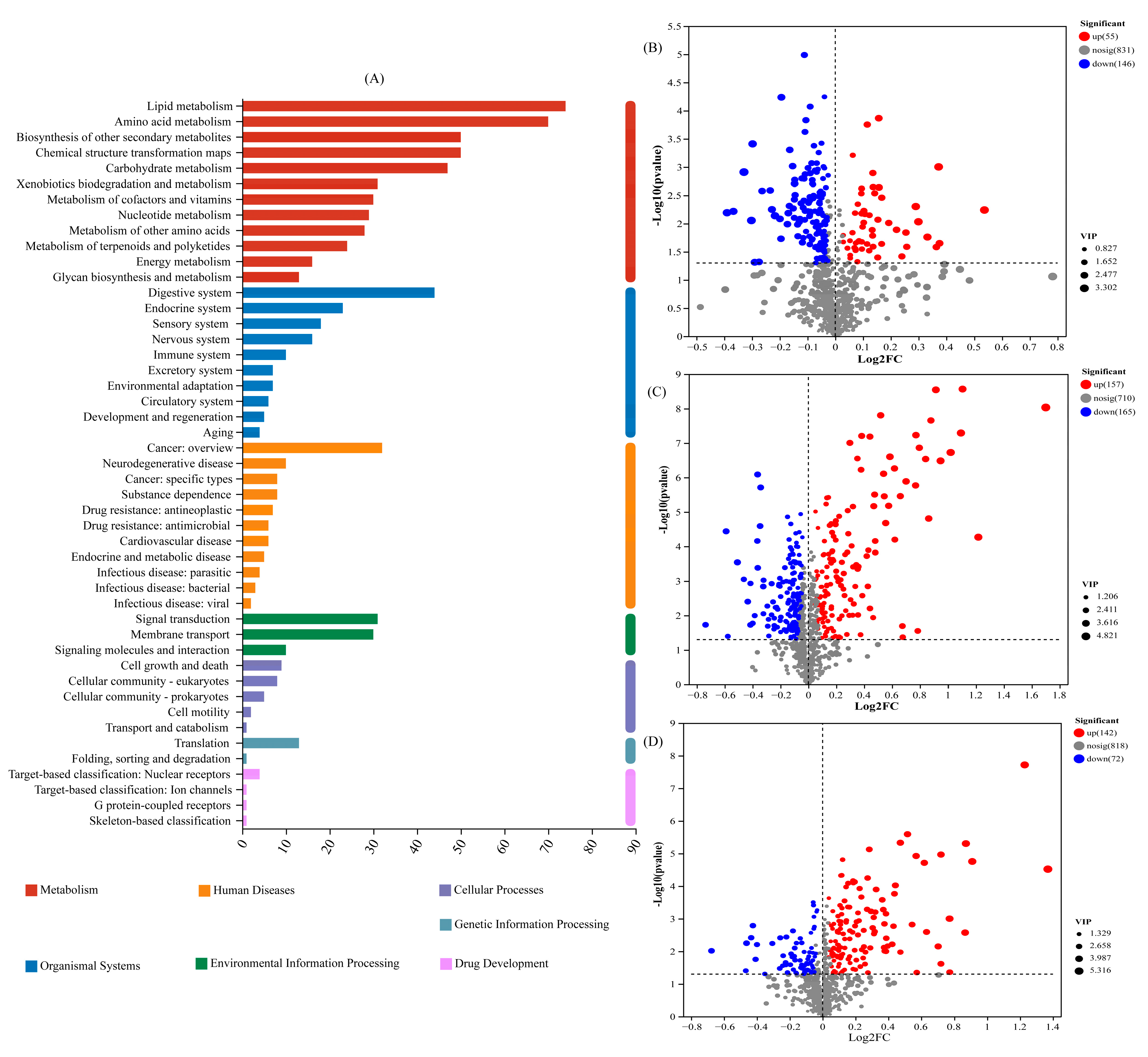
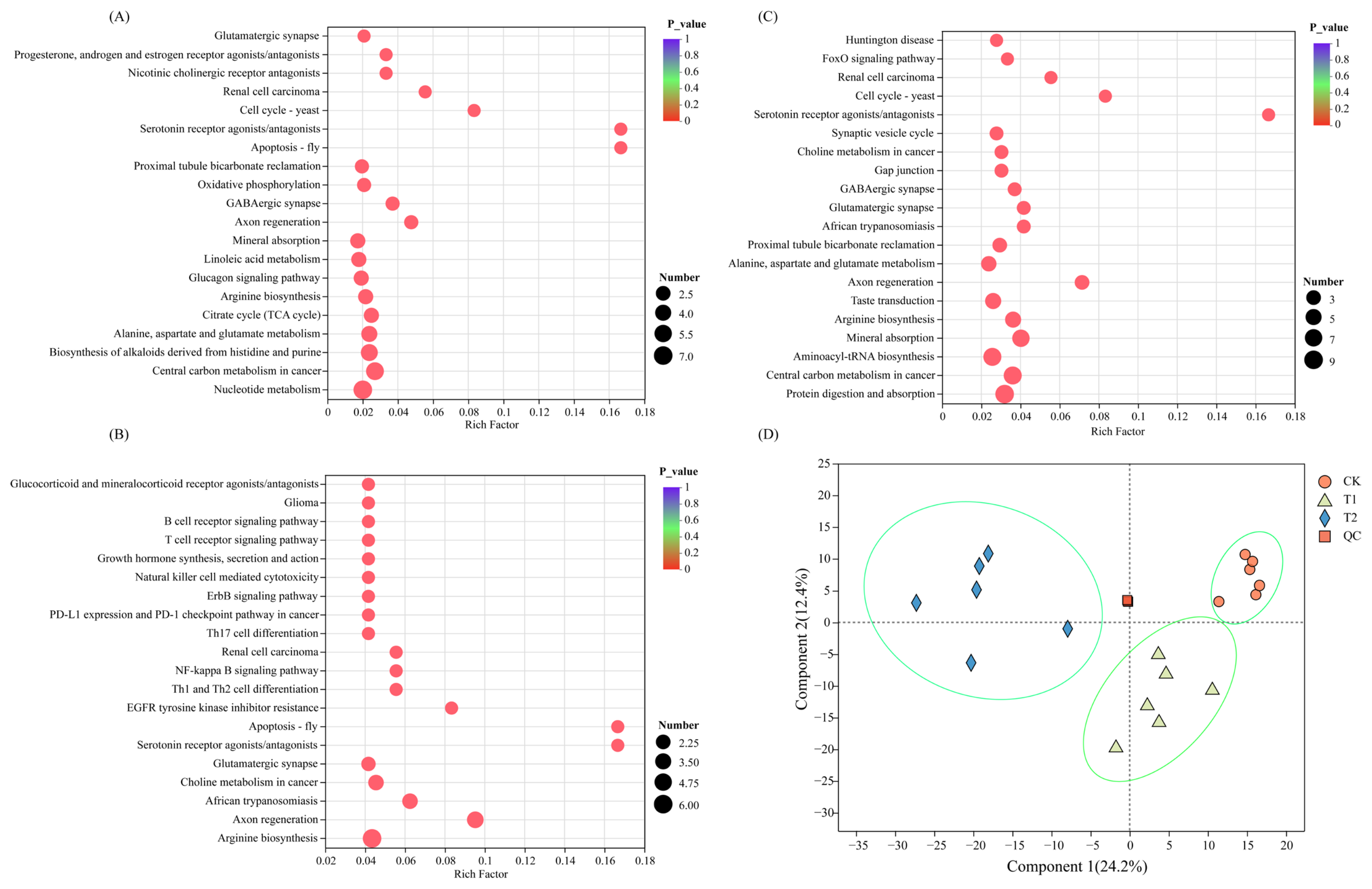

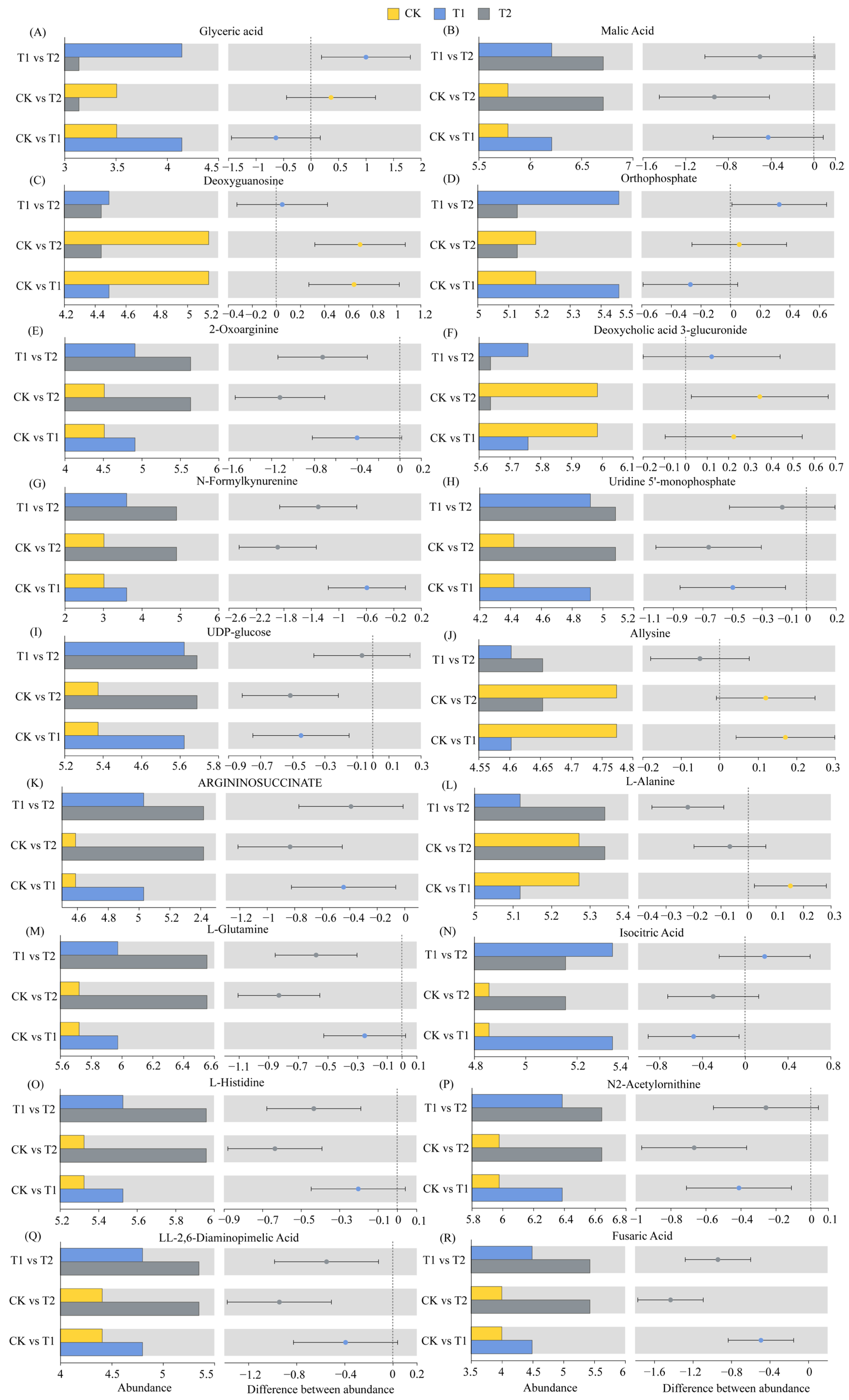
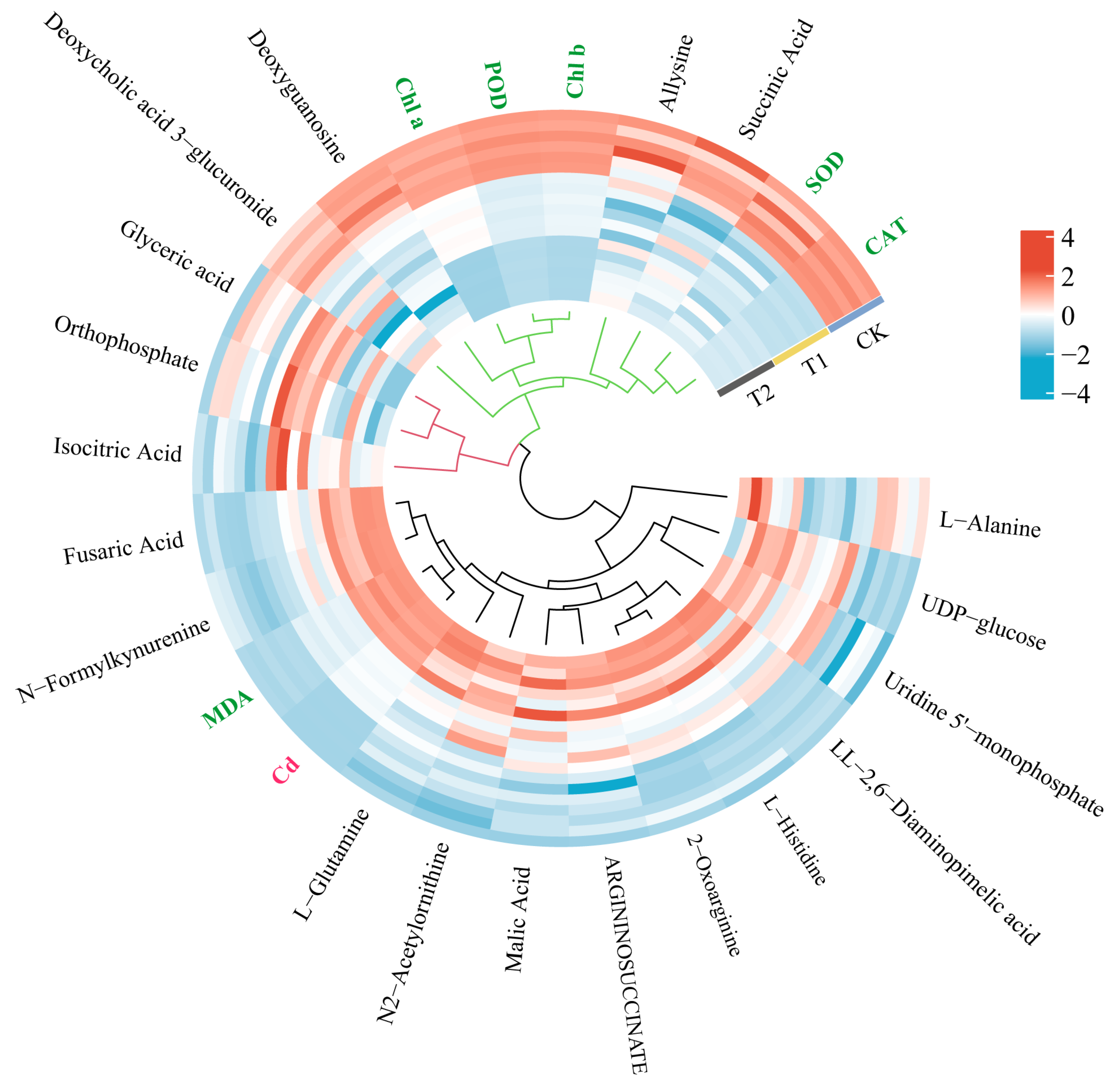
Disclaimer/Publisher’s Note: The statements, opinions and data contained in all publications are solely those of the individual author(s) and contributor(s) and not of MDPI and/or the editor(s). MDPI and/or the editor(s) disclaim responsibility for any injury to people or property resulting from any ideas, methods, instructions or products referred to in the content. |
© 2025 by the authors. Licensee MDPI, Basel, Switzerland. This article is an open access article distributed under the terms and conditions of the Creative Commons Attribution (CC BY) license (https://creativecommons.org/licenses/by/4.0/).
Share and Cite
Zhu, Y.; Lin, D.; Li, Q.; An, M.; Lv, J. Metabolomic Analysis of the Responses of Bryophyte Tortella tortuosa (Hedw.) Limpr. to Cadmium (Cd) Stress. Int. J. Mol. Sci. 2025, 26, 2856. https://doi.org/10.3390/ijms26072856
Zhu Y, Lin D, Li Q, An M, Lv J. Metabolomic Analysis of the Responses of Bryophyte Tortella tortuosa (Hedw.) Limpr. to Cadmium (Cd) Stress. International Journal of Molecular Sciences. 2025; 26(7):2856. https://doi.org/10.3390/ijms26072856
Chicago/Turabian StyleZhu, Yongqi, Dongmei Lin, Qiuge Li, Mengjie An, and Jie Lv. 2025. "Metabolomic Analysis of the Responses of Bryophyte Tortella tortuosa (Hedw.) Limpr. to Cadmium (Cd) Stress" International Journal of Molecular Sciences 26, no. 7: 2856. https://doi.org/10.3390/ijms26072856
APA StyleZhu, Y., Lin, D., Li, Q., An, M., & Lv, J. (2025). Metabolomic Analysis of the Responses of Bryophyte Tortella tortuosa (Hedw.) Limpr. to Cadmium (Cd) Stress. International Journal of Molecular Sciences, 26(7), 2856. https://doi.org/10.3390/ijms26072856




